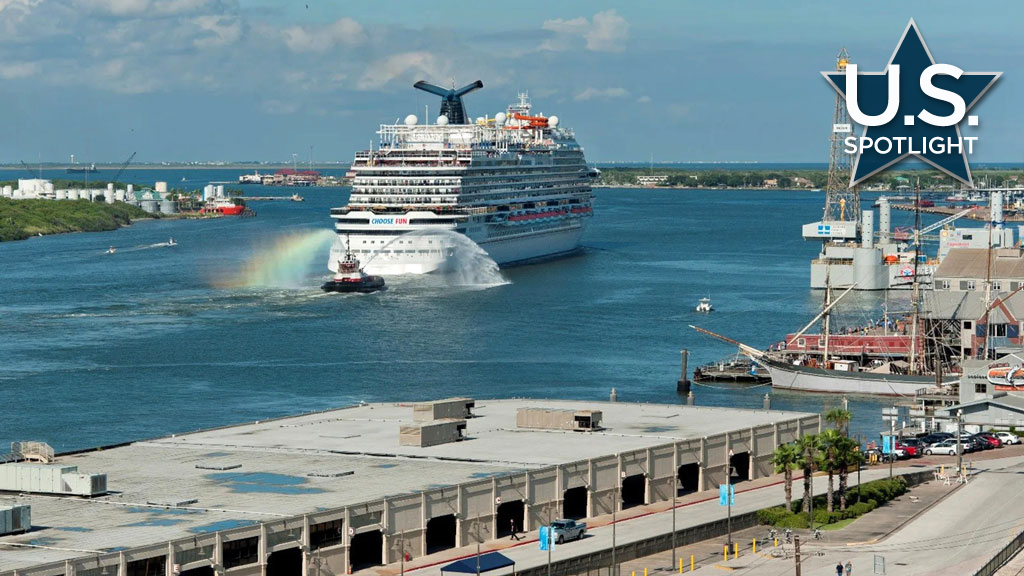A recent announcement made jointly by Galveston Wharves and Swiss-based MSC Cruises is the next step forward in the ongoing expansion of cruise and commercial ship traffic for the Port of Galveston.
Work will begin this year on what will be the port’s fourth cruise terminal. It will be the home port for the 1112-foot MSC Seascape beginning November 2025.
The $140 million development results from two years of negotiation between Galveston Wharves and MSC, a 20-year agreement with five-year extension options.
The project includes the conversion of a former Del Monte Foods cargo warehouse into a 165,000-square-foot cruise terminal, parking garage, passenger boarding bridge and other infrastructure improvements.
Galveston has been a thriving maritime commercial center since 1825. Just 45 minutes from open seas, the 840-acre port has infrastructure and assets that serve the growing cruise, cargo and commercial businesses.
In the early 1980s, the port began development towards the promotion of tourism. Under the port’s forward-looking 40-Year Strategic Master Plan, further improvements are envisioned to enhance public access and enjoyment. The agreement with MSC is the latest step in the Port’s expansion.
“We’re excited about this mutually beneficial public-private partnership,” said Galveston Wharves port director and CEO Rodger Rees. ”Adding MSC to our family of cruise lines offers our cruise guests an elegant, European-style family cruise experience,” said Rees. “It also elevates our status as a top U.S. cruise home port and moves us up to the eighth largest cruise port in the global market, while paving the way for MSC to reach millions of cruise passengers in the Central U.S.”
“Galveston is unique among Texas ports in two big ways. It’s the Lone Star State’s only cruise port and it’s the only public port with a commercial area open to the public. Nowhere else in Texas can you sit at a waterfront restaurant and watch cruise and cargo ships sail by.”
The Port of Galveston is currently the fourth most popular cruise home port in the U.S. It hosted 1.49 million cruise passengers in 2023, a 43 percent increase over 2022, marking a quick recovery from the COVID lows in 2020 when total passengers fell to under 500,000.
Cruise ship traffic is playing an increasingly important role in the Port of Galveston’s future.
In November 2022, Royal Caribbean International (RCI) opened Galveston’s third cruise terminal. The $125 million facility allows the port to host Royal Caribbean’s Oasis Class ships, the largest passenger cruise ships in the world.
The RCI terminal itself was remarkable in that it was the first LEED Zero Energy cruise terminal facility in the world, capable of generating 100 per cent of its energy needs through onsite solar panels.
The port is municipally-owned by the City of Galveston and managed by the Galveston Wharves board of trustees. The port is self-sustaining and does not receive any taxpayer funding.
The new MSC terminal will be funded by port cash reserves and revenue bonds, due to Galveston Wharves’ singular financial strength. In 2023, it reported preliminary unaudited operating revenues of $67.4 million, a 27.5 per cent increase over the prior year, and a net operating income of $24.5 million, a 55.4 per cent increase over the previous year. This represents the highest revenue and net operating income in the Port’s history.
The Port has a significant impact on the city of 50,000.
Cruise activity alone in 2022 supported 3,500 jobs, and created $568 million in local business revenue and $73.5 million in local purchases by passengers and crew. The new fourth cruise terminal is forecast to generate an additional 925 jobs and $177 million in local business revenue annually.
Commercial ship traffic is also important to Galveston Wharves.
Rees told the American Journal of Transportation, “We are growing our business like never before.”
Over $50 million will be spent to modernize and expand its West Port Cargo Complex, funded by State grants and its own financial reserves. Planned expansion of the West Port Cargo Complex is expected to increase the cargo area by one-third in size, to approximately 90 acres.
The port has long been a key transportation hub for a long list of essential food and industrial products.
However, the port is shifting towards more profitable “roll-on/roll-off” shipments like automobiles imported from Germany, project cargo, and specialized freight that cannot fit in standard containers, Rees said. He added that the port created a 22-acre Free Trade Zone in 2023 for the importation of wind turbine components.
Galveston Wharves will continue to look at public-private partnerships like the MSC Terminal agreement, identifying how they can accelerate future development, bring in new opportunities, and reduce investment risks.











Recent Comments
comments for this post are closed